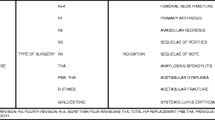Abstract
Purpose
Periprosthetic fracture (PPF) is a devastating complication following primary total knee arthroplasty. Obesity is currently considered a risk factor for many complications in orthopaedics, but there is no evidence in literature about the relationship between obesity and PPF around the knee. The objective of this study was to determine whether obesity is associated with a higher incidence of PPF.
Methods
All patients diagnosed of a PPF around the knee from January 2010 to December 2013 were enrolled. Forty-nine PPF (47 women and 2 men) were included, and a total of 97 patients (80 women and 17 men) were randomly obtained as a control group. Body mass index (BMI) was obtained in both groups and classified as <25 (normal), overweight (25–29.9), obese (30–34.9), very obese (35–39.9), or morbid obesity (≥40). Both groups, were also divided into subpopulations depending on the age as follows: <70, 70–75, 75–80 and ≥80. Statistical analysis was performed to determine any difference in BMI ≥30 kg/m² distribution between groups.
Results
In the PPF group 61.22 % of the patients had a BMI over 30 kg/m² and likewise 62.88 % of the patients in the control group. No association was found between obesity and a higher risk of PPF (p < 0.05).
Conclusion
As a conclusion, obesity (BMI ≥30 kg/m²) does not have any clinical relationship with the appearance of a periprosthetic fracture around the knee (p < 0.05).

Similar content being viewed by others
References
Sarmah SS, Patel S, Reading G et al (2012) Periprosthetic fractures around total knee arthroplasty. Ann R Coll Surg Engl 94:302–307. doi:10.1308/003588412X13171221592537
Dennis D (2001) Periprosthetic fractures following total knee arthroplasty. Instr Course Lect 50:379–89
Su ET, DeWal H, Di Cesare PE (2004) Periprosthetic femoral fractures above total knee replacements. J Am Acad Orthop Surg 12:12–20
Sterling RS (2003) Supracondylar femur fractures after total knee arthroplasty. Curr Opin Orthop 14:34–40. doi:10.1097/00001433-200302000-00009
Kim W, Song JH, Kim J-J (2015) Periprosthetic fractures of the distal femur following total knee arthroplasty: even very distal fractures can be successfully treated using internal fixation. Int Orthop 39:1951–1957. doi:10.1007/s00264-015-2970-9
Bezwada HP, Neubauer P, Baker J et al (2004) Periprosthetic supracondylar femur fractures following total knee arthroplasty. J Arthroplast 19(4):453–8
Parratte S, Pesenti S, Argenson JN (2014) Obesity in orthopedics and trauma surgery. Orthop Traumatol Surg Res 100:S91–S97. doi:10.1016/j.otsr.2013.11.003
Sabharwal S, Root MZ (2012) Impact of obesity on orthopaedics. J Bone Joint Surg Am 94(11):1045–52. doi:10.2106/JBJS.K.00330
Mihalko WM, Bergin PF, Kelly FB, Canale ST (2014) Obesity, orthopaedics, and outcomes. J Am Acad Orthop Surg 22(11):683–690
Finucane MM, Stevens GA, Cowan MJ et al (2011) National, regional, and global trends in body-mass index since 1980: systematic analysis of health examination surveys and epidemiological studies with 960 country-years and 9.1 million participants. Lancet 377:557–567. doi:10.1016/S0140-6736(10)62037-5
Kapadia BH, Berg RA, Daley JA et al (2015) Periprosthetic joint infection. Lancet S0140-6736(14)61798-0. doi:10.1016/S0140-6736(14)61798-0
World Health Organization (2009) Global health risks: mortality and burden of disease attributable to selected major risks. World Health Organization, Geneva
Lehmann W, Rupprecht M, Nuechtern J et al (2012) What is the risk of stress risers for interprosthetic fractures of the femur? a biomechanical analysis. Int Orthop 36:2441–2446. doi:10.1007/s00264-012-1697-0
Mäkinen TJ, Dhotar HS, Fichman SG, et al. (2015) Periprosthetic supracondylar femoral fractures following knee arthroplasty: a biomechanical comparison of four methods of fixation. Int Orthop 1737–1742. doi:10.1007/s00264-015-2764-0
Singh J, Jensen M, Harmsen S, Lewallen D (2013) Are gender, comorbidity, and obesity risk factors for postoperative periprosthetic fractures after primary total hip arthroplasty? J Arthroplast 28(1):126–31. doi:10.1016/j.arth.2012.03.010, e1-2
Koenig K, Huddleston JI, Huddleston H et al (2012) Advanced age and comorbidity increase the risk for adverse events after revision total hip arthroplasty. J Arthroplasty 27:1402–1407.e1. doi:10.1016/j.arth.2011.11.013
Acknowledgments
The authors would like to thank Prof. Dr. Juan Carlos Díaz Alcaide and Prof. Dra. María de los Ángeles Miñarro del Moral for their continuous help and support. Moreover, special thanks to Maria del Carmen Ruiz Bonilla and Rafael Carlos Muñoz López for giving the initial idea. Orthopaedics is much simpler thanks to them.
Author information
Authors and Affiliations
Corresponding author
Rights and permissions
About this article
Cite this article
Minarro, J.C., Urbano-Luque, M.T., Quevedo-Reinoso, R. et al. Is obesity related with periprosthetic fractures around the knee?. International Orthopaedics (SICOT) 40, 1583–1586 (2016). https://doi.org/10.1007/s00264-015-3071-5
Received:
Accepted:
Published:
Issue Date:
DOI: https://doi.org/10.1007/s00264-015-3071-5




